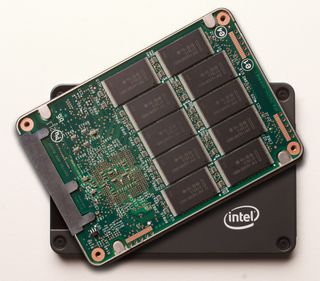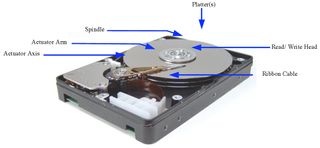Solid State Drive Buyer's Guide
Should you consider upgrading to a solid state drive? Weigh all the pros and cons and evaluate the cost and value of doing so by reading this guide.
Drive Anatomy

If you’re one of the countless many who carry around a USB flash drive, you’re already a solid state drive user of sorts. After all, a flash drive is little more than a flash memory chip or two mounted on a printed circuit board (PCB). The interface may differ from that of an internal system drive, but the system command codes are the same. Another key difference is that the controller on a USB drive rests inside the PC while an SSD or HDD will have a controller built onto the drive’s PCB. The speed benefits of an on-board controller should be fairly obvious. Which would be more effective: walking out to the adjacent building to get instructions from your manager or poking your head around the corner into the next cubicle?
To take this metaphor one step further, imagine each memory chip as a worker. If a bunch of papers come in that need filing, two workers can get the job done in less time than one. Similarly, if papers need to be fetched and sent out, then the more workers, the faster the task performance. This is why “dual-channel” flash drives with two memory chips perform faster than a single-channel drive with one chip and why bargain-oriented SSDs with five flash chips on their PCBs will perform slower than more expensive drives with 10 chips. There are several other factors that affect performance, as we’ll see, but this is one of the most important.

A hard drive uses platters, much like old LP records in concept, mounted on a rotating spindle. A read/write head mounted on an arm extends over the platter surface and uses a magnetic field to control the orientation of particles on the platter’s surface. The magnetic orientation of groups of these particles represent binary bits—0s or 1s. The density of these particles and the number of platters in the drive dictate the drive’s total capacity. To read or write data, the drive controller must instruct the head to move into exactly the right position over the platter, and this “seek time” is one of the main causes of delay inherent in hard disk technology. If your application only needs to perform one seek followed by a long period of continuous reading or writing (such as when playing back a media file), then total throughput performance is much better than when it has to seek many tiny blocks of information scattered across the platter’s surface.
The difference between streaming and random reads/writes is a bit like finding certain bits of music on an LP. With streaming, you might grab the needle arm, position it right above the gap between tracks 1 and two, then lower it and just let the music play. But with random reads, you might want to stay playback 10 seconds into track 1, 20 seconds into track 4, 50 seconds into track three, etc., and only play each of those segments for five seconds each. There's a lot of hopping around the platter, and you're going to spend an inordinate amount of time trying to precisely position the needle over the exact right spot in each track. It's all that "seeking" time that kills you. Random seeks are what kill hard drive performance.
“Solid state” simply means an electronic device comprised of non-moving parts. A solid state drive is little more than memory chips, an intelligent controller, a circuit board, power and data interfaces, and a rugged external case. Actually, some internal SSDs dispense with the case and are meant to simply plug into an I/O slot on the motherboard, such as the mini PCI Express slot in notebooks.

Sign up to get the BEST of Tom's Guide direct to your inbox.
Get instant access to breaking news, the hottest reviews, great deals and helpful tips.
Current page: How SSD Works vs. Traditional Hard Drives (HDD) - Tom’s Guide
Prev Page Why Buy an SSD - Benefits of Solid State Drives - Tom’s Guide Next Page SSD Pros and Cons - Read, Write Speed vs. HDD - Tom’s GuideWilliam Van Winkle is a freelance editor and tech journalist who has been writing for more than 20 years. His work has appeared on Tom's Guide, Tom's Hardware, Tom's IT Pro, AMD, Seagate, Computer Shopper, and more. He is also an author, writing poetry, short stories, and science fiction and fantasy books.
-
Shadow703793 Imo, I'd keep away with any SSD drive using a JMicron. Dosen't matter if the stutering,etc issues were fixed. Indylinx and Intel controllers are the best right now.Reply
Anyways, I got an X25-M G2 (OEM) for $220 @Newegg during Black Friday. -
grimjester The point about getting a small SSD for software and a larger disk for data can't be stressed enough. The price per GB looks completely different if you only need 64G. There's little difference in price between the cheapest hard drive you can get and the cheapest 500G one.Reply
An SSD is just an extra cost of $150-300. It has no practical effect on the storage space your computer has. -
Eggrenade I wouldn't say it's better than Anandtech's; there's no mention of random reads or writes, which is why performance just after startup is so good. It's also a lot less technical, which is probably better for most Tom's Guide readers.Reply -
Tomsguiderachel EggrenadeI wouldn't say it's better than Anandtech's; there's no mention of random reads or writes, which is why performance just after startup is so good. It's also a lot less technical, which is probably better for most Tom's Guide readers.Exactly :)Reply -
Tomsguiderachel nonxcarbonxThis is an even better ssd article than anandtech's ssd anthology. Nice work.Thank you. I hope it was a good fit for Tom's Guide readers' needs.Reply -
Next page broken http://www.tomsguide.com/us/ssd-value-performance,review-1455-11.html, sorry couldnt find anywhere to submit feedback. Page not working on firefox 3.5.5 (does not scroll).Reply
-
Tomsguiderachel none007Next page broken http://www.tomsguide.com/us/ssd-va 55-11.html, sorry couldnt find anywhere to submit feedback. Page not working on firefox 3.5.5 (does not scroll).I'm using the same browser and that page works for me. I will report the bug, thanks.Reply -
Tomsguiderachel TomsguiderachelI'm using the same browser and that page works for me. I will report the bug, thanks.Oh--I see that you mean the final page of the article not the penultimate page. FYI There is no content on that last page so you didn't miss part of the article.Reply -
tommysch I think Ill stick to my 4x1TB RAID 0 array for now. BTW they are ghosted each week. o_0Reply
